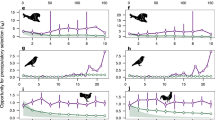Summary
Seasonal changes in sex ratios during a 4-year study of red-necked phalaropes and a 3-year study of Wilson's phalaropes showed that females preceded males to breeding and/or courtship areas. The degree to which females preceded males may have been constrained by harsh weather, as the arrival of red-necked phalaropes was synchronous in 1983, when spring was unusually late. Neither sex defended territories; females competed vigorously for direct access to males. These findings show that selection for sexually asynchronous arrival need not act through territoriality. We interpret early female arrival as an adaptation for obtaining mates and coclude that sexual selection may be an important determinant of arrival times in mate defense social systems.
Similar content being viewed by others
References
Alatalo RV, Lundberg A, Ståhlbrandt K (1984) Female mate choice in the pied flycatcher Ficedula hypoleuca. Behav Ecol Sociobiol 14:253–261
Altmann J (1974) Observational study of behavior: sampling methods. Behaviour 49:227–267
Altmann SA, Wagner SS, Lenington S (1977) Two models for the evolution of polygyny. Behav Ecol Sociobiol 2:397–410
bishop YMM, Fienberg SE, Holland PW (1975) Discrete multivariate analysis: theory and practice. M.I.T. Press, Cambridge, Massachustts
Colgan PW, Smith JT (1978) Multidimensional contingency table analysis. In: Colgan PW (ed) Quantitative ethology. John Wiley & Sons, New York, pp 145–174
Cramp S, Simmons KEL (eds) (1983) The birds of the western palearctic, vol 3. Oxford University Press, Oxford
Darwin CR (1871) The descent of man and selection in relation to sex. Murray, London
Gauthreaux SA, Jr (1978) The ecological significance of behavioral dominance. In: Bateson PPG, Klopfer PH (eds) Perspectives in ethology. Plenum Press, New York, pp 17–54
Gauthreaux SA, Jr (1982) The ecology and evolution of avian migration systems. In: Farner DS, King JR, Parkes KC (eds) Avian biology, vol 6. Academic Press, New York, pp 93–168
Gregory PT (1974) Patterns of spring emergence of the redsided garter snake (Thamnophis sirtalis parietalis) in the Interlake region of Manitoba. Can J Zool 52:1063–1069
Halliday TR (1983) The study of mate choice. In: Bateson P (ed) Mate choice. Cambridge University Press, Cambridge, pp 3–32
Heldt R (1966) Zur Brutbiologie des Alpenstrandläufers, Calidris alpina schinzii. Corax 1:173–188
Hildén O, Vuolanto S (1972) Breeding biology of the rednecked phalarope Phalaropus lobatus in Finland. Ornis Fenn 49:57–85
Höhn EO (1967) Observations on the breeding biology of Wilsons's phalarope (Steganopus tricolor) in central Alberta. Auk 84:220–244
Höhn EO (1968) Some observations on the breeding of northern phalaropes at Scammon Bay, Alaska. Auk 85:316–317
Höhn EO (1971) Observations on the breeding behaviour of grey and red-necked phalaropes. Ibis 113:335–348
Holmes RT (1966) Breeding ecology and annual cycle adaptations of the red-backed sandpiper (Calidris alpina) in northern Alaska. Condor 68:3–46
Howe MA (1975a) Behavioral aspects of the pair bond in Wilson's phalarope. Wilson Bull 87:248–270
Howe MA (1975b) Social interactions in flocks of courting Wilson's phalaropes (Phalaropus tricolor). Condor 77:24–33
Iwasa Y, Odendaal FJ, Murphy DD, Ehrlich PR, Launer AE (1983) Emergence patterns in male butterflies: a hypothesis and a test. Theor Pop Biol 23:363–379
Jefferies RL, Jensen A, Abraham KF (1979) Vegetational development and the effect of geese on vegetation at La Pérouse Bay, Manitoba. Can J Bot 57:1439–1450
Jehl JR, Jr (1973) Breeding biology and systematic relationships of the stilt sandpiper. Wilson Bull 85:115–147
Johns JE (1969) Field studies of Wilson's phalarope. Auk 86:660–670
Kagarise CM (1979) Breeding biology of the Wilson's phalarope in North Dakota. Bird-banding 50:12–22
Ketterson ED, Nolan V Jr (1976) Geographic variation and its climatic correlates in the sex ratios of eastern-wintering dark-eyed juncos (Junco hyemalis hyemalis). Ecology 57:679–693
Ketterson ED, Nolan V Jr (1983) The evolution of differential bird migration. In: Johnston RF (ed) Current ornithology, vol 1. Plenum Press, New York, pp 357–402
Kistchinski AA (1975) Breeding biology and behaviour of the grey phalarope Phalaropus fulicarius in east Siberia. Ibis 117:285–301
Lack D (1968) Ecological adaptations for breeding in birds. Chapman & Hall, London
Mayfield HF (1979) Red phalaropes breeding on Bathurst Island. Living Bird 17:7–39
Michener GR (1983) Spring emergence schedules and vernal behavior of Richardson's ground squirrels: why do males emerge from hibernation before females? Behav Ecol Sociobiol 14:29–38
Michener GR (1984) Age, sex, and species differences in the annual cycles of ground-dwelling scuirids: implications for sociality. In: Murie JO, Michener GR (eds) The biology of ground-dwelling squirrels. University of Nebraska Press, Lincoln, Nebraska
Myers JP (1981) A test of three hypotheses for latitudinal segregation of the sexes in wintering birds. Can J Zool 59:1527–1534
Oring LW (in press) Avian polyandry: a review, In: Johnston RF (ed) Current ornithology, vol 3. Plenum Press, New York
Oring LW, Davis WM (1966) Shorebird migration at Norman, Oklahoma: 1961–63. Wilson Bull 78:166–174
Oring LW, Lank DB (1982) Sexual selection, arrival times, philopatry and site fidelity in the polyandrous spotted sandpiper. Behay Ecol Sociobiol 10:185–191
Petrie M (1983) Female moorhens compete for small fat males. Science 220:413–415
Raner L (1972) Förekommer polyandri hos smalnäbbad simsnäppa (Phalaropus lobatus) och svartsnäppa (Tringa erythropus)? Fauna Flora 3:135–138
Rausch MJ (1982) Mating systems and the breeding biology of the northern phalarope (Phalaropus lobatus). B Sc Thesis, Queen's University, Kingston, Ontario
Reynolds JD (1984) Sex-role reversal in the red-necked phalarope: effects on arrival times and philopatry. M Sc Thesis, Queen's University Kingston, Ontario
Reynolds JD (1985) Philandering phalaropes. Nat Hist 94:58–65
Schamel D, Tracy D (1977) Polyandry, replacement clutches, and site tenacity in the red phalarope (Phalaropus fulicarius) at Barrow, Alaska. Bird-banding 48:314–324
Soikkeli M (1967) Breeding cycle and population dynamics in the dunlin (Calidris alpina). Ann Zool Fenn 4:158–198
Verner J (1964) Evolution of polygamy in the long-billed marsh wren. Evolution 18:252–261
Yasukawa K (1981) Male quality and female choice of mate in the red-winged blackbird (Aeglaius phoeniceus) Ecology 62:922–929
Author information
Authors and Affiliations
Rights and permissions
About this article
Cite this article
Reynolds, J.D., Colwell, M.A. & Cooke, F. Sexual selection and spring arrival times of red-necked and Wilson's phalaropes. Behav Ecol Sociobiol 18, 303–310 (1986). https://doi.org/10.1007/BF00300008
Received:
Accepted:
Issue Date:
DOI: https://doi.org/10.1007/BF00300008




